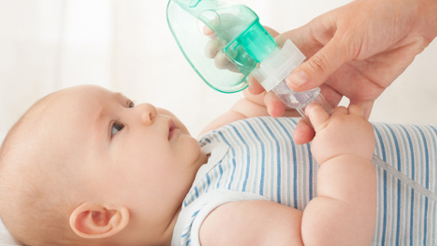Bronchiolitis is a common lung infection among infants. It can cause coughing, wheezing, and a hard time with breathing. While most cases can be treated at home, it’s also the leading reason infants are admitted to a hospital. Adults can get it, too, but it’s very rare and usually related to other infections or injuries.
It happens when small breathing tubes in the lungs called bronchioles become infected. This causes the tubes to clog up with mucus so there’s not enough room for air to get in and out of the lungs. It usually affects children younger than 2 years old in winter and early spring.
Symptoms
The first signs look a lot like a cold. Your child may have the following symptoms:
- Runny nose
- Cough
- Fever
- Stuffy nose
- Less appetite
The symptoms may get worse over the next few days, including faster breathing. If you see signs that your child is having trouble breathing, call her doctor at once or seek medical care if your call isn’t answered. Otherwise, here are some other things to watch for:
- Wheezing (a high-pitched, whistling sound when exhaling)
- Fast breathing (more than 60 breaths a minute)
- Labored breathing and grunting
- Trouble drinking, sucking, swallowing
- Signs of dehydration such as dry mouth, crying without tears, not peeing as often
- Vomiting
- Sluggish or tired appearance
- Constant coughing
- Pause in breathing for more than 15 seconds (called apnea)
Call 911 and get emergency medical care if these things happen:
- Your child has severe trouble breathing.
- She seems confused or sluggish.
- Her lips, fingertips, ears, tongue, the tip of her nose or the inside of her cheek have a blue tint.
Causes
Bronchiolitis is usually caused by a viral infection. Many different viruses can be the culprit, including the flu, but the most common is what’s called respiratory syncytial virus, or RSV.
Outbreaks of this virus happen every winter, and most children have had it by the time they turn 3. They may only get mild symptoms, but in severe cases it can cause bronchiolitis or pneumonia.
Prevention
Bronchiolitis is contagious. Viral infections spread through droplets in the air, so you can contract it the same way you get infected with colds or flus. While it’s hard to stop a viral infection, you can lower your child’s chance of getting it if you:
- Stay away from others who are sick.
- Practice good handwashing.
- Disinfect surfaces, toys and objects that you and your kids often touch.
- Avoid smoking in the home, because it raises risks of breathing issues.
- Schedule a flu shot, which is recommended for everyone older than 6 months.
Prevention
Bronchiolitis is contagious. Viral infections spread through droplets in the air, so you can contract it the same way you get infected with colds or flus. While it’s hard to stop a viral infection, you can lower your child’s chance of getting it if you:
- Stay away from others who are sick.
- Practice good handwashing.
- Disinfect surfaces, toys and objects that you and your kids often touch.
- Avoid smoking in the home, because it raises risks of breathing issues.
- Schedule a flu shot, which is recommended for everyone older than 6 months.
Diagnosis
When you see your doctor, he’ll ask about your child’s symptoms and medical history. He’ll likely give her a physical exam. He may use a stethoscope to listen to her breathing and count the breaths per minute. Doctors rarely order X-rays or blood tests for bronchiolitis. But if your child’s symptoms are severe or it’s unclear what’s causing them, she may get these tests:
Chest X-ray
This is done to look for possible signs of pneumonia.
Blood tests
Blood is taken to check the white blood cell count (these are cells that fight infection).
Pulse oximetry
A sensor is taped to your child’s finger or toe to measure how much oxygen is in her blood.
Nasopharyngeal swab
Your doctor will insert a swab into her nose to get a sample of mucus that will be tested for viruses.
Treatment
There is no cure. It usually takes about 2 or 3 weeks for the infection to go away. Antibiotics and cold medicines are not effective in treating it. Most children with bronchiolitis can be treated at home. There, you should watch to see if your child’s symptoms get worse or she has breathing problems.
- Your doctor may suggest these home treatments:
- Give her plenty of liquids.
- Use nose drops or sprays to help with a runny nose.
- Use a bulb syringe, which is an at-home method to remove mucus from the nose.
- Prop up her head with an extra pillow (but don’t do this if she’s under a year old).
About 3% of children with bronchiolitis need to go to a hospital. If your child does, the treatments may include:
- Fluid and nutrition given through a tube into a vein (IV)
- Oxygen therapy to help your child breathe
- Suctioning of her nose and mouth to take out mucus
Typically, most kids feel better and can go home in about 2 to 5 days. If your child’s case is more severe, and she needs a machine to help her breathe, it could mean a longer stay -- about 4 to 8 days.
Courtesy: WebMD

